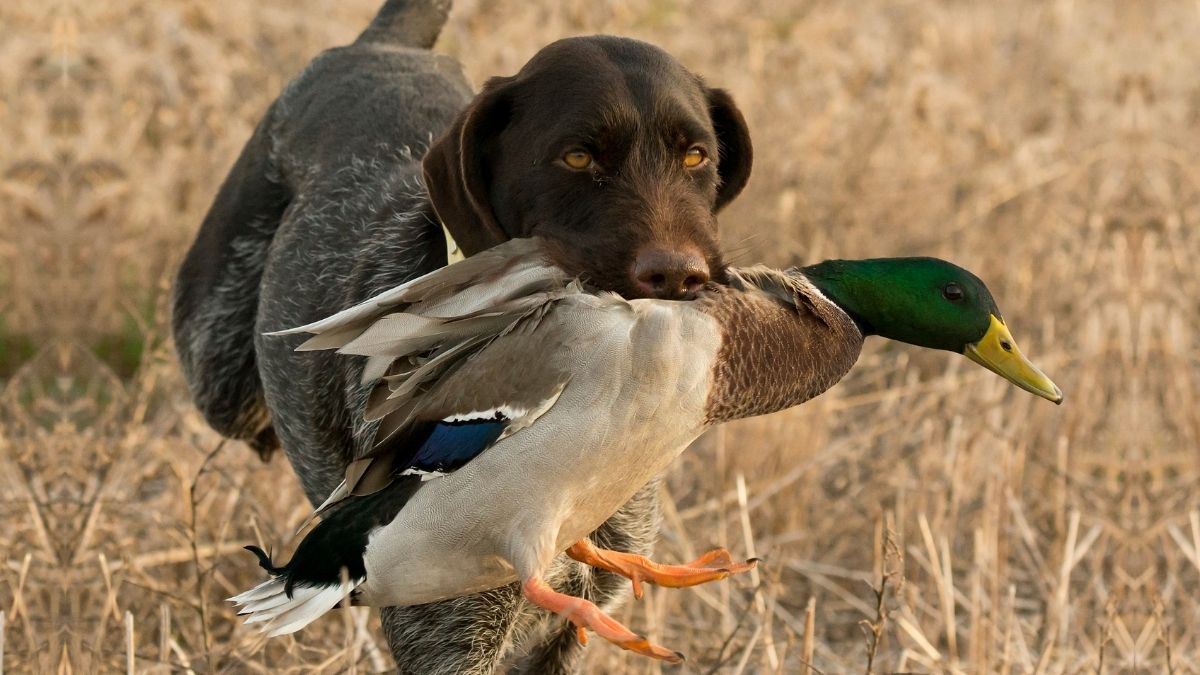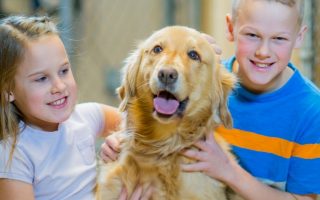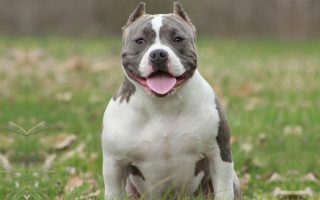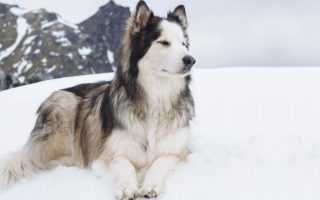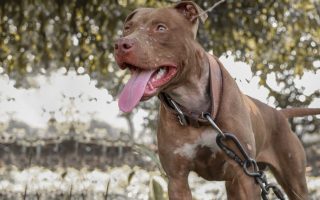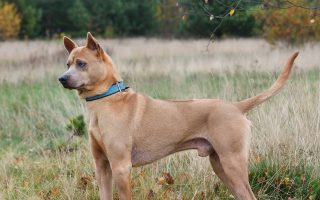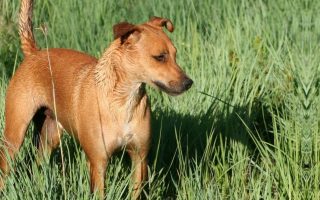Hunting was a favorite hobby and a profession for many men in centuries past.
To ease their tasks, many hunting dogs were developed. These dogs had different roles, but the similar purpose of helping the hunter catch prey.
Duck hunters were developed to catch ducks both on land and at sea. Some flushed out the ducks, others retrieved them unharmed, and the functions often overlapped.
These duck hunting breeds are spaniels, retrievers, pointers, and everything in between.
Waterfowl hunting—and hunting in general—isn’t as widespread in many places as it used to be.
However, duck hunting dog breeds have found their places in many homes, with some gaining massive popularity. They are now excellent companions, albeit with their share of challenges.
Here’s a list of the 15 best duck hunting breeds of dogs that you might consider a good fit for your home as they make good family dogs.
The Best Duck Hunting Dog Breeds That Make Good Companions
1. Labrador Retriever
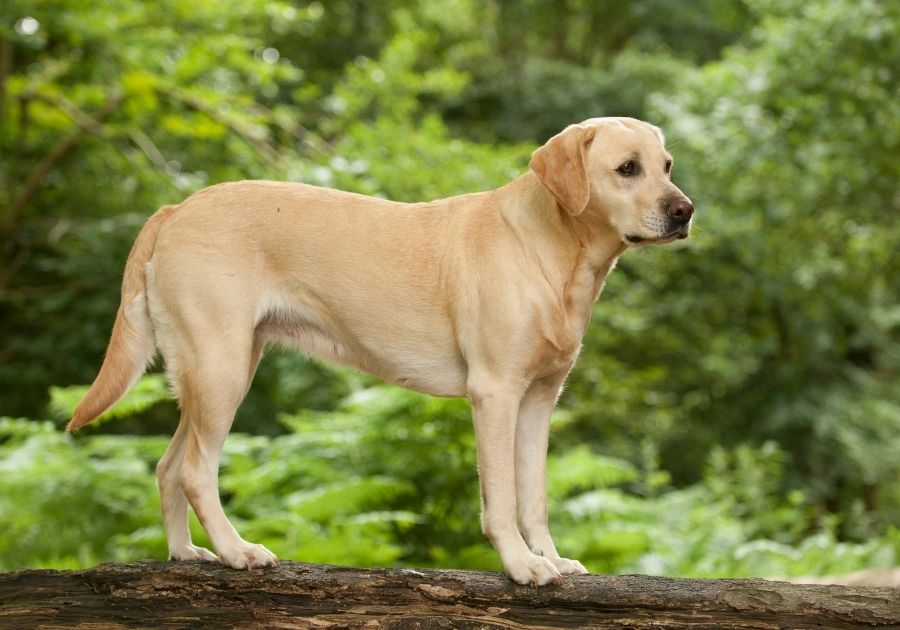
- Height: 21 to 24 inches
- Weight: 55 to 80 pounds
- Coat Type: Double, wiry, soft
- Coat Colors: Black, chocolate, yellow
- Temperament: Intelligent, kind, agile
- Life Expectancy: 10 to 12 years
The Labrador Retriever is possibly the most recognizable breed on this list as this is the most popular here, as well as being the most popular breed in the entire United States.
It has successfully maintained a 31-year streak, a testament to its good behavior. Labradors were developed in Canada to retrieve waterfowl.
The household Labrador Retriever is friendly towards everyone, strangers and kids inclusive. They can even cope in a house with cats if well socialized.
These dogs are suitable for new pet parents, but any prospective owner should keep in mind that Lab is a hyperactive dog.
2. Golden Retriever
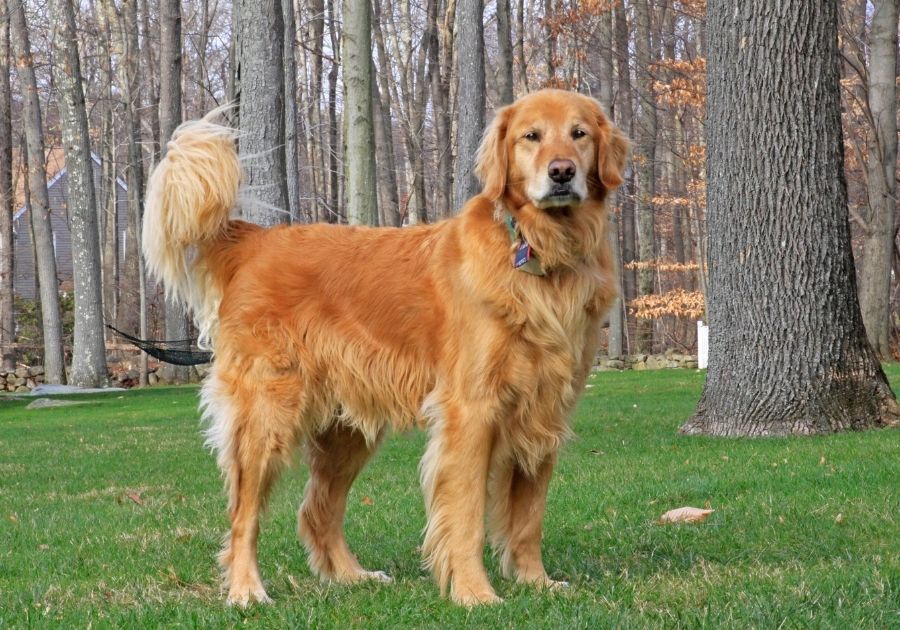
- Height: 21 to 24 inches
- Weight: 55 to 75 pounds
- Coat Type: Double, dense, thick
- Coat Colors: Gold
- Temperament: Intelligent, reliable, kind
- Life Expectancy: 10 to 12 years
The Golden Retriever may not be as popular as the Lab, but it is certainly not less loved.
This breed easily captures the heart of many individuals, including people who are wary of dogs.
Its golden coat and homely appearance are enough to warm the heart. It was also developed for retrieval.
This breed is filled with potential. Besides still having the flair to work, the Golden Retriever is considered the 2nd most intelligent dog breed after the Border Collie.
It has an admirable personality, isn’t too noisy, and is loyal. It does have a high energy level, which can be a deal-breaker for some pet parents.
Dive Deeper:
Labrador Retriever Vs Golden Retriever Differences & Facts
3. American Cocker Spaniel
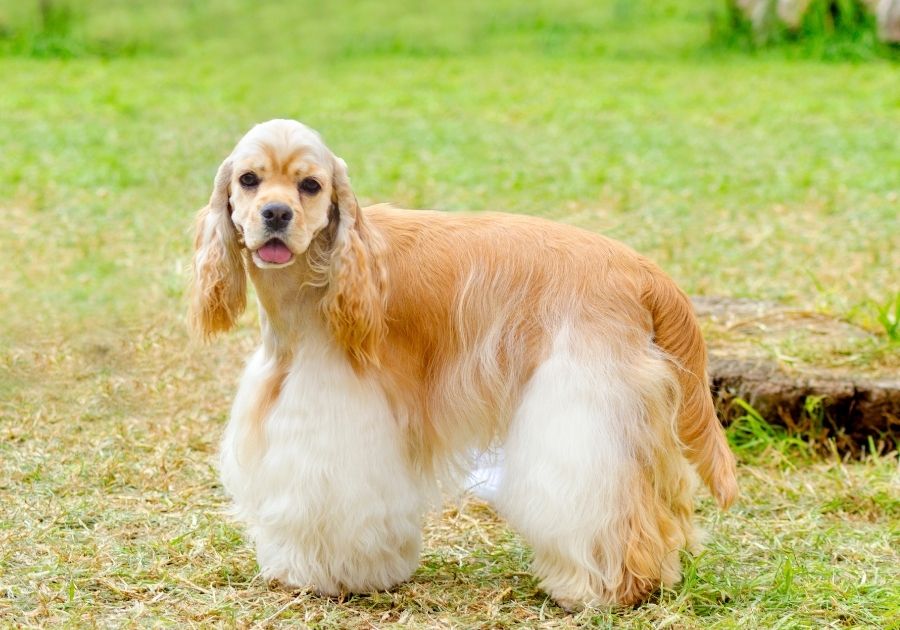
- Height: 14 to 15 inches
- Weight: 24 to 28 pounds
- Coat Type: Thick, wavy
- Coat Colors: Black, cream, red, brown
- Temperament: Playful, Affectionate, friendly
- Life Expectancy: 12 to 15 years
The American Cocker Spaniel—simply called the Cocker Spaniel in the United States—is the smallest member of the AKC’s Sporting Group, and one of the most loved.
Made popular by Disney’s Lady and the Tramp, the American Cocker Spaniel has warmed the heart of many Americans.
Way before its fame, it was a hunting dog, operating on both land and water.
What gives the Cocker Spaniel an edge over the Labrador and Golden Retrievers is its ability to fit into an apartment.
Though energetic, it is not as intense as the aforementioned retrievers. It is sweet, cuddly, and sensitive, a good family dog for those who enjoy loads of doggy affection.
4. English Cocker Spaniel
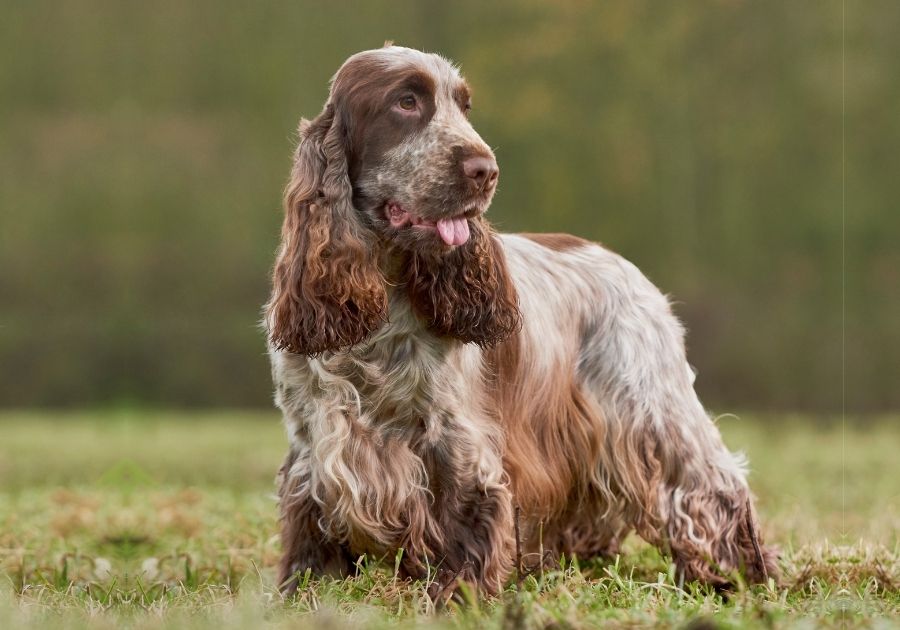
- Height: 15 to 17 inches
- Weight: 26 to 34 pounds
- Coat Type: Medium, flat, wavy
- Coat Colors: Black, liver, red
- Temperament: Playful, Affectionate, friendly
- Life Expectancy: 12 to 14 years
The English Cocker Spaniel and the American Cocker Spaniel were once considered the same breed.
This changed in the 1930s when the differences between both breeds became very obvious.
The English Cocker Spaniel is bigger than its American counterpart, but both have similar personalities and played the same roles.
This breed shows a load of affection and love for its family members and people in general, though it might be reserved towards strangers, unlike the breeds already listed.
English Cocker Spaniels can make good watchdogs, but don’t count on them to do any more security service than that.
5. Curly Coated Retriever
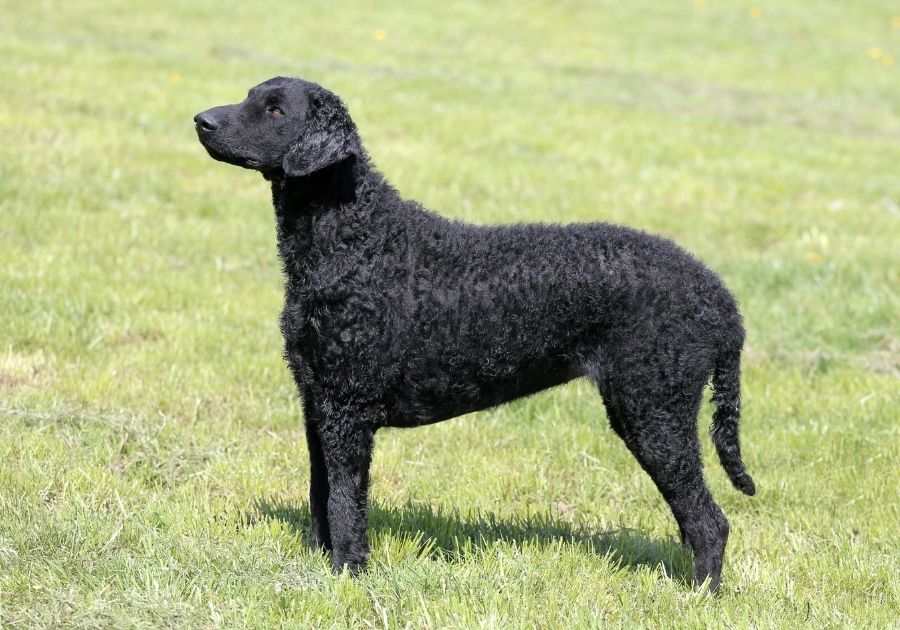
- Height: 23 to 27 inches
- Weight: 65 to 100 pounds
- Coat Type: Curly, oily,
- Coat Colors: Black, liver
- Temperament: Intelligent, clever, sensitive
- Life Expectancy: 9 to 12 years
The Curly-Coated Retriever is unique because of its coat that’s full of curly hair. This accounts for its name.
It was developed in the United Kingdom for hunting and is considered the first dog that was officially meant for retrieving.
It retained its popularity till the Labrador came into the scene, and while it never quite regained its popularity, it is in a comfortable place.
Besides the coat, what differentiates the Curly Coated Retriever from the Labrador and the Golden Retriever is its aloofness towards strangers.
It also tends to be more independent and even stubborn compared to the popular retrievers.
While some novice owners can have a shot with the Curly-Coated, it is not always advisable. That said, this breed is loyal, confident, and determined.
Dive Deeper:
6 Types Of Retrievers – Which Breed Is Best For Me?
6. Flat-Coated Retriever
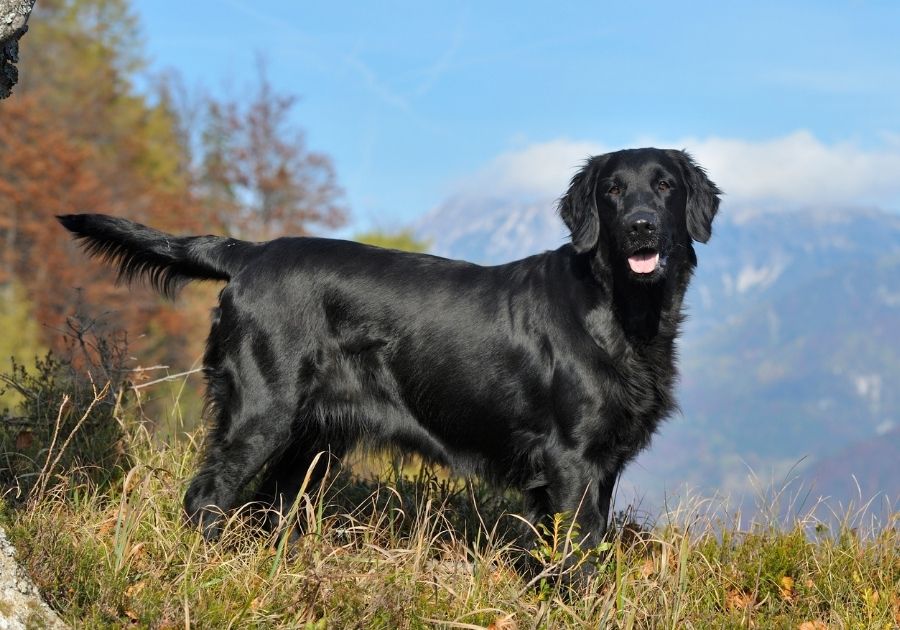
- Height: 23 to 27 inches
- Weight: 80 to 100 pounds
- Coat Type: Medium, silk, thick
- Coat Colors: Black, liver
- Temperament: Smart, friendly, cheerful
- Life Expectancy: 10 to 12 years
The Flat-Coated Retriever looks similar to the Golden Retriever, and some people might consider the Flat-Coated Retriever to be a Golden Retriever mix.
That’s not the case as the Flat-Coated Retriever is a distinct breed of its own, and its existence preceded that of the Golden Retriever.
Like the Curly-Coated, this breed was popular before the Labrador and Golden took over.
The uniqueness of the Flat-Coated Retriever is in its low grooming need, compared to other retrievers mentioned so far.
The only time you’d need to put in more effort is when it is shedding. Personality-wise, the Flat-Coated Retriever has often been dubbed the Peter Pan of dogs as it takes longer to mature, which just adds to its charm.
7. English Springer Spaniel
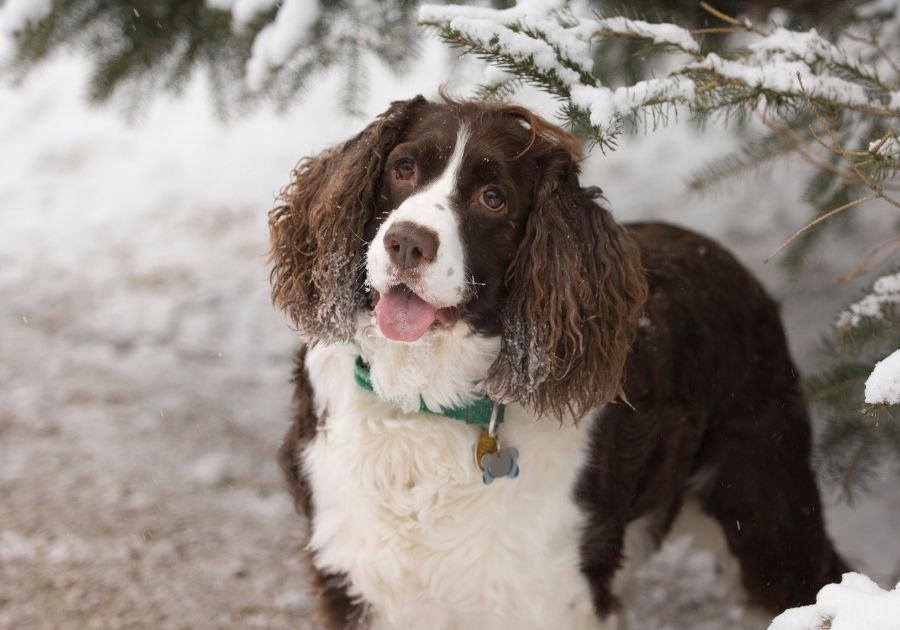
- Height: 18 to 22 inches
- Weight: 45 to 55 pounds
- Coat Type: Double, wavy, soft
- Coat Colors: Black, white, blue, roan
- Temperament: Affectionate, intelligent, cheerful
- Life Expectancy: 9 to 15 years
The English Springer Spaniel can be compared to both the English and American Cocker Spaniel.
It is the biggest of the three and as Spaniels they all flushed prey for hunters, including ducks.
The English Springer Spaniel was so named because of the way it springs at prey.
This breed is highly affectionate and a lover of attention. It enjoys being around its family a lot, and won’t do well in a home where everyone has a job or other commitments taking them outside.
It is good for new pet parents, but not so much for apartment dwellers.
8. Irish Water Spaniel
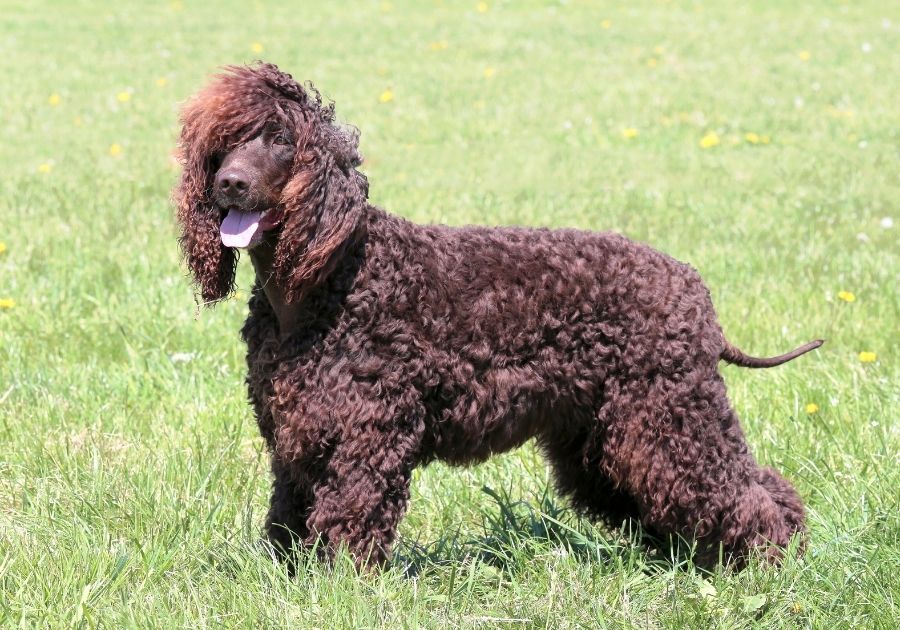
- Height: 21 to 24 inches
- Weight: 45 to 65 pounds
- Coat Type: Double, medium, curly
- Coat Colors: Liver
- Temperament: Alert, comical, inquisitive
- Life Expectancy: 10 to 12 years
The Irish Water Spaniel and the Poodle (that we’ll soon look into) are both similar in looks but are different breeds by a large gap.
Some people suggest the Poodle might have been an ancestor of the Irish Water Spaniel, but even at that, they are not the same.
The Irish Water Spaniel is considered the biggest of all Spaniels and was developed to be a versatile hunting dog.
It played the roles of hunting, pointing, and retrieving. The “Water” in its name alludes to its swimming skills.
As a family dog, the Irish Water Spaniel is playful and friendly with family members but also reserved towards strangers.
9. Boykin Spaniel
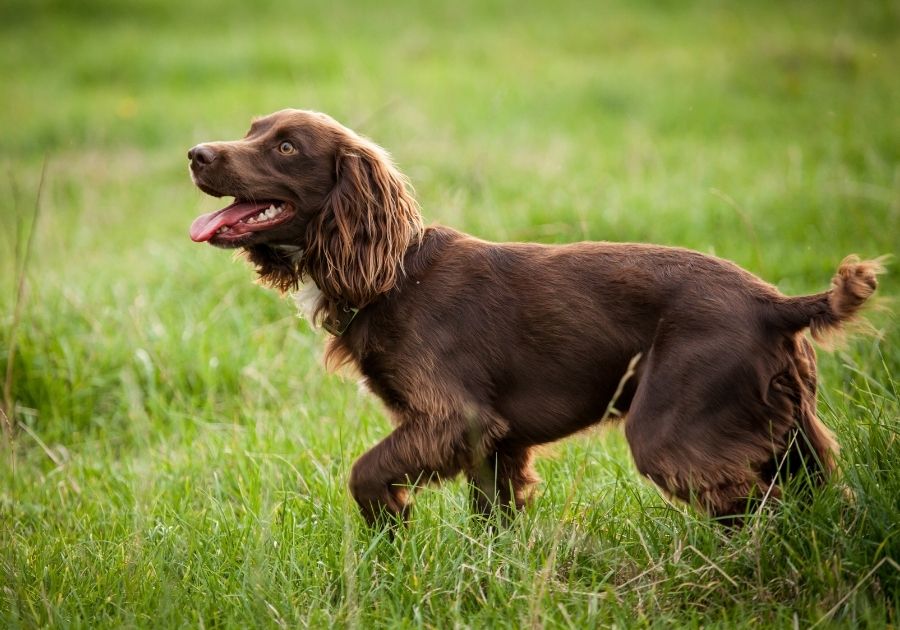
- Height: 14 to 18 inches
- Weight: 25 to 40 pounds
- Coat Type: Medium, flat, wavy
- Coat Colors: Liver, brown, chocolate
- Temperament: Intelligent, energetic, eager
- Life Expectancy: 10 to 12 years
The Boykin Spaniel is an uncommon breed, and it was developed in South Carolina to hunt turkey and waterfowl. It has the best of Spaniel qualities, with a strong work ethic, fine looks, and a good dose of friendliness.
It was a favorite hunting dog, just as it soon became a companion for those who could get one.
A highly trainable breed, the Boykin Spaniel is perfect for new pet parents because of its willingness to please.
It is also intelligent, another bonus. Boykin Spaniel flourishes in an active home, and it loves swimming.
10. Poodle (Standard)
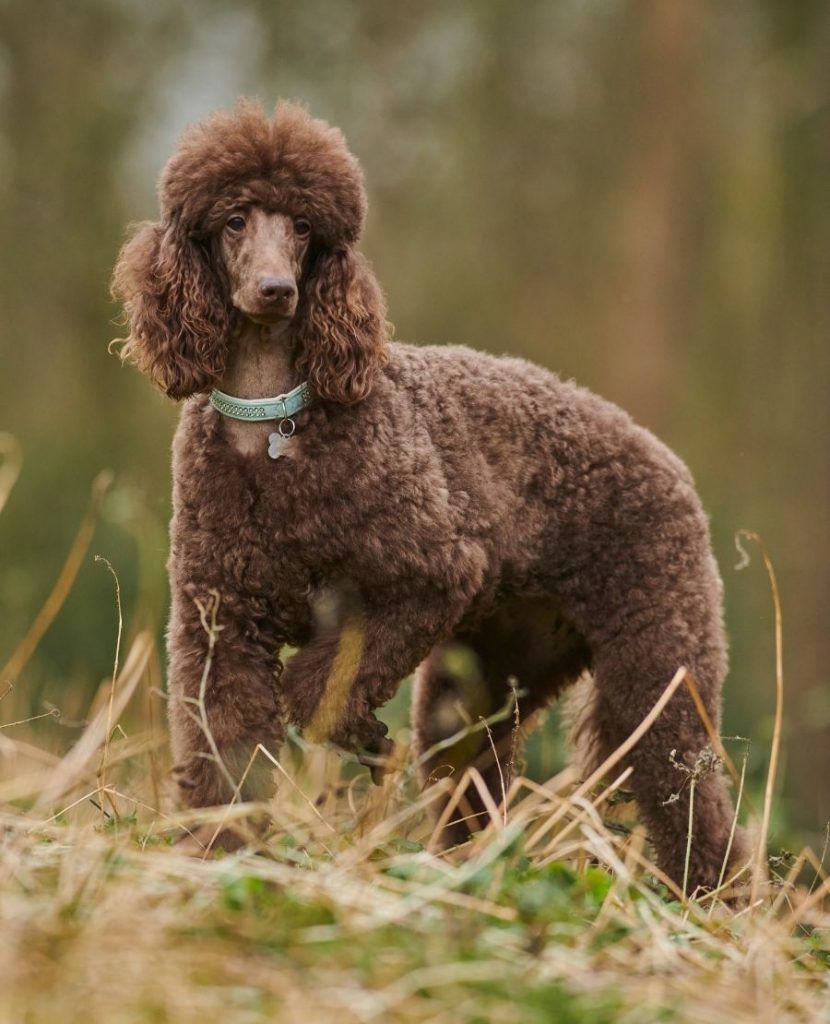
- Height: 15 to 22 inches
- Weight: 45 to 70 pounds
- Coat Type: Dense, curly
- Coat Colors: Black, blue, white
- Temperament: Intelligent, alert, active
- Life Expectancy: 12 to 15 years
The Poodle comes in three sizes, Toy, Mini, and Standard. Of all three, the Standard Poodle was the hunting dog.
The Poodle isn’t considered a true retriever or spaniel—though it looks like an Irish Water Spaniel, as we pointed out—it was used to retrieve waterfowl for hunters.
The Poodle is smart and is considered one of the most intelligent dog breeds, debunking the stereotype of it being dumb.
It is also very friendly, and though some people assume it is aloof because of its elegant appearance, the Poodle is friendly with everyone it meets.
11. German Shorthaired Pointer
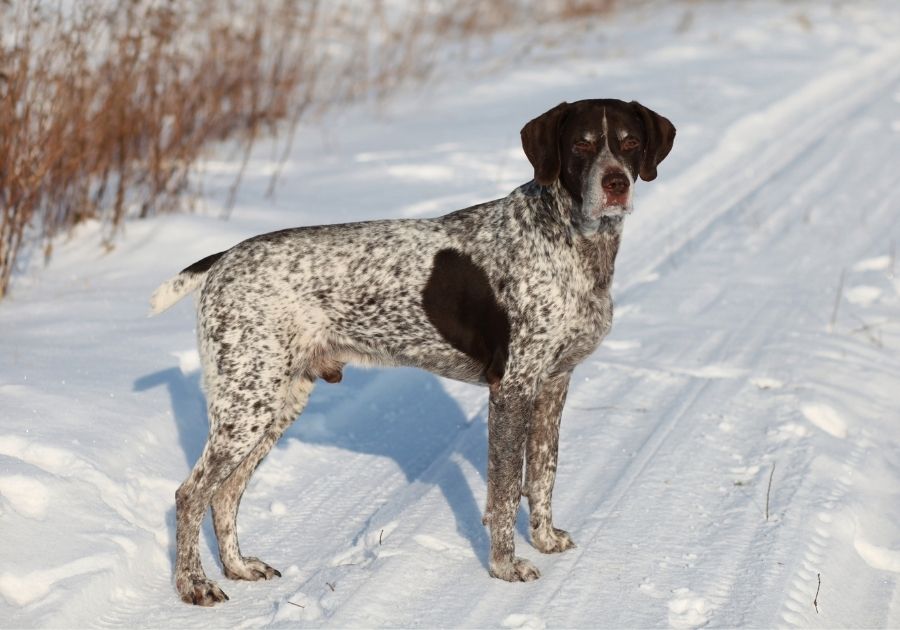
- Height: 23 to 25 inches
- Weight: 55 to 70 pounds
- Coat Type: Short, thick
- Coat Colors: White, liver
- Temperament: Intelligent, boisterous, affectionate
- Life Expectancy: 12 to 15 years
German Shorthaired Pointer was a duck hunter, but its prey isn’t limited to ducks. It was also known to go after deer and some other furry pets.
Its uniqueness is in the short hair, and it happens to be the only duck hunting dog with such hair. Not surprisingly, it is easy to groom.
The German Shorthaired Pointer is an enthusiastic dog, and it can liven up a place once it comes in.
This enthusiasm is linked to a high energy level, and you should always exercise regularly to avoid destructive behaviors.
12. Italian Spinone
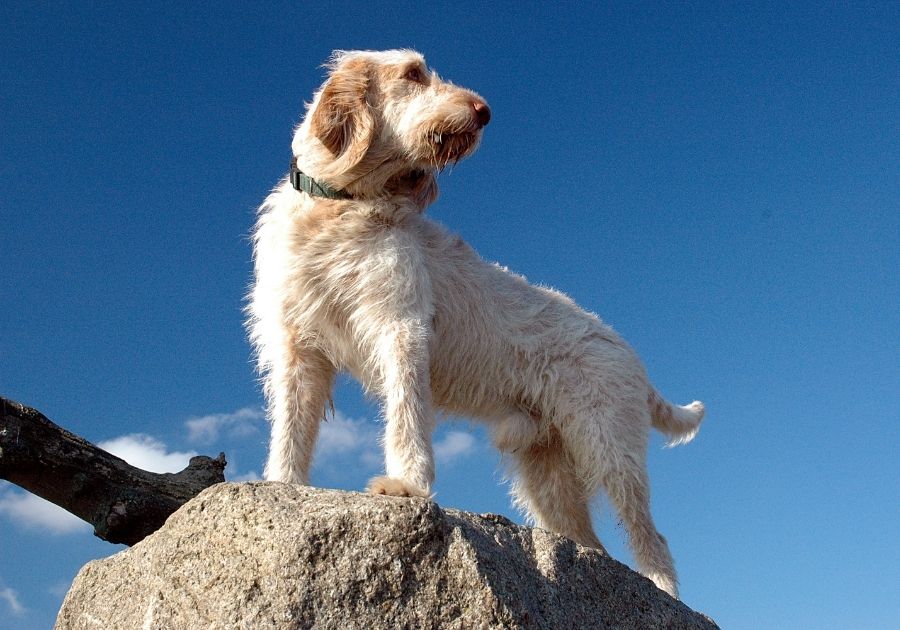
- Height: 22 to 28 inches
- Weight: 61 to 86 pounds
- Coat Type: Medium, wiry, dense
- Coat Colors: Orange and white, brown and white, solid white
- Temperament: Docile, patient, affectionate
- Life Expectancy: 10 to 14 years
Italian Spinone is an ancient dog breed, and one of the oldest hunting dog breeds still in existence today. It hailed from Italy and was used to hunt waterfowl.
The Italian Spinone is considered very healthy, and because of its good health, it is slowly rising in popularity. It is still considered rare, though.
The Italian Spinone is a friend of everyone and it accommodates even strangers. It only has bad blood against small animals because of its hunting instincts.
It loves activities and enjoys being outdoors, though not without its family.
13. German Wirehaired Pointer
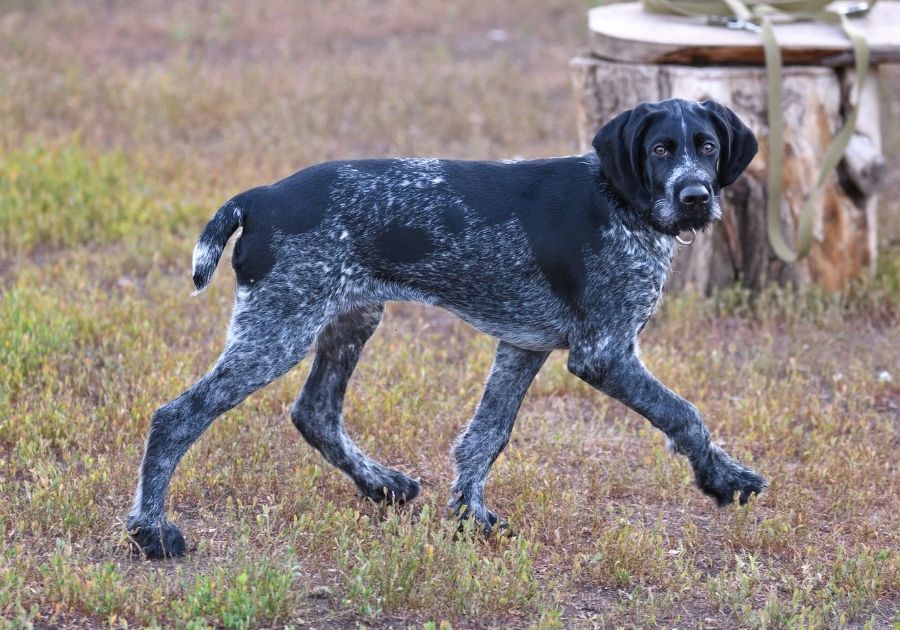
- Height: 22 to 26 inches
- Weight: 60 to 70 pounds
- Coat Type: Double, wiry, coarse
- Coat Colors: Liver, white
- Temperament: Intelligent, affectionate, friendly
- Life Expectancy: 12 to 14 years
The German Wirehaired Pointer is also known as the Deutsch Drahthaar. Its ancestors are the Pointer, the Foxhound, and the Poodle.
The best qualities of these 3 breeds were picked out to form the German Wirehaired Pointer.
This breed is highly loyal to its family and friendly to everyone it knows. It is aloof to strangers, however, and should be socialized to accept those it doesn’t know.
The German Wirehaired Pointer is also stubborn and independent, making it not suitable for new pet parents.
14. Nova Scotia Duck Tolling Retriever
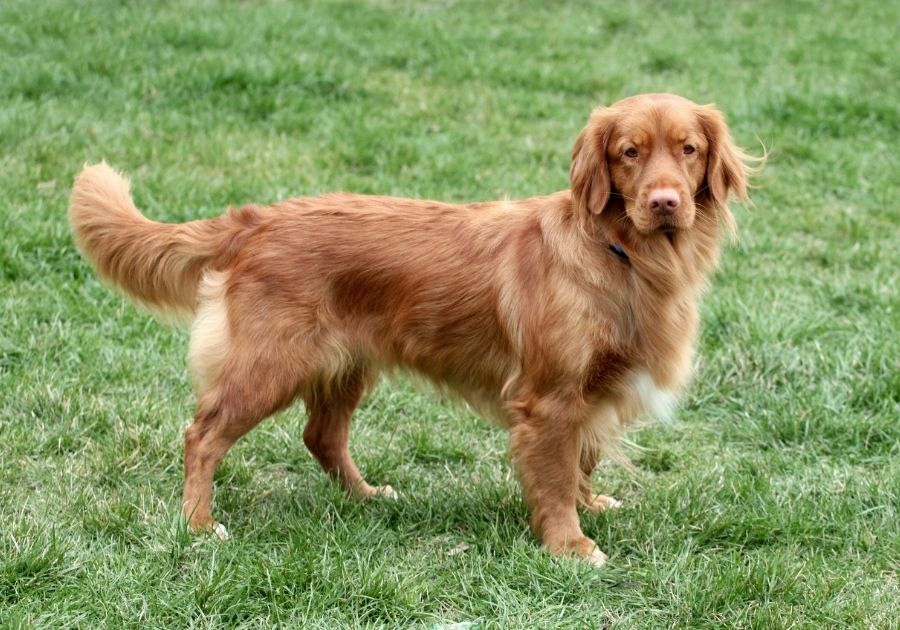
- Height: 17 to 21 inches
- Weight: 35 to 50 pounds
- Coat Type: Double, thick, soft
- Coat Colors: Red, orange
- Temperament: Intelligent, alert, patient
- Life Expectancy: 10 to 14 years
The Nova Scotia Duck Tolling Retriever is often termed a “Tolling” retriever or a “decoy” dog, both of which point to this breed’s main role.
It was employed to lure ducks out of their hiding places to where the hunter can easily get them to fly and then shoot. Thereafter, Nova Scotia picks up any fallen one.
It is currently a rare retriever, and it isn’t uncommon for people to see it as a miniature Golden Retriever or a Golden mix.
Its personality is often similar to the Golden Retriever, but with a dose of the Terrier spirit.
New pet parents can own one, but they should be prepared to give it enough exercise. Ditto for apartment dwellers.
15. Chesapeake Bay Retriever
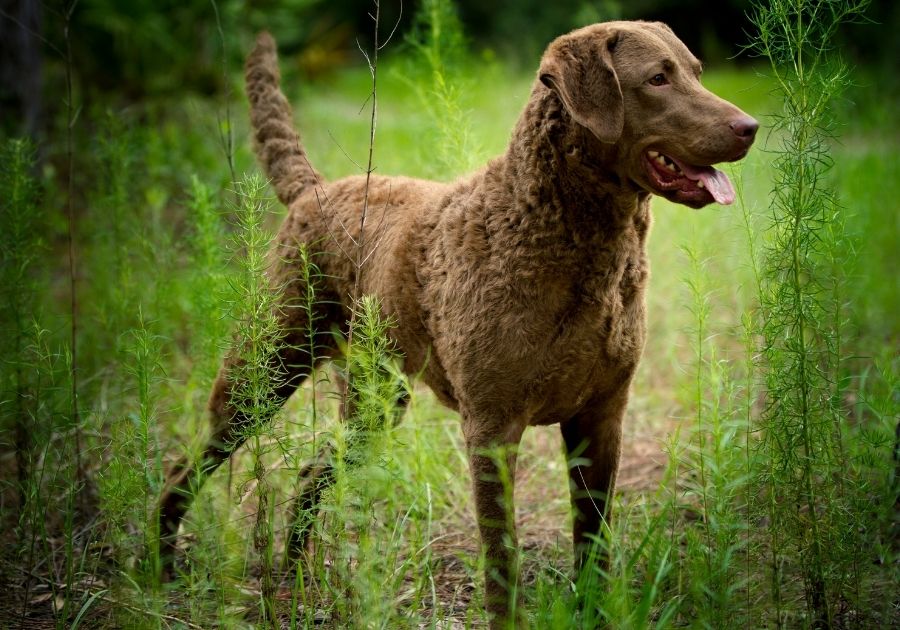
- Height: 21 to 26 inches
- Weight: 65 to 80 pounds
- Coat Type: Double, short, dense
- Coat Colors: Brown, sedge, tan
- Temperament: Intelligent, affectionate, happy
- Life Expectancy: 10 to 12 years
The Chesapeake Bay Retriever is a very strong and stubborn duck hunting breed, qualities that helped it survive the harsh weather in the Chesapeake Bay where it originated.
It was a formidable hunter, and stories had it that it could capture 100 ducks daily. It also loved to swim, so if you own a Chesapeake Bay Retriever, find a place for it to swim.
The Chesapeake Bay Retriever’s personality is not what you’d expect from a retriever. It isn’t too enthusiastic, especially towards strangers.
While it is affectionate towards its family, even proper socialization won’t make it act like a Labrador towards people it doesn’t know.
It needs a confident owner too. First-timers need not apply.
FAQs
Are duck hunting dogs good for the family?
In general, duck hunting dogs make good family dogs because of their positive personalities.
They were bred to work alongside hunters, so they enjoyed human company right from time.
What is a duck hunting dog?
Duck hunting dogs assisted hunters in finding, drawing out, and retrieving prey.
Some worked on the land, some on water, and a third category could navigate both terrains.
Wrap Up
If you are interested in getting a waterfowl hunting dog, you have a lot of options to choose from amongst our best duck hunting dog breeds list.
Your experience, environment, and exercise level should be kept in mind while choosing one.
First-time pet parents with a wide environment can go for the Labrador or Golden Retrievers. Apartment dwellers might find the Cocker Spaniels suitable for them. You get the drill.
From your experience, If there are any other waterfowl hunting breeds we didn’t mention, do tell us in the comments below.
References & Notes
- Fogle, Bruce (2000) [1995]. The Encyclopedia of the Dog. Dorling Kindersley. ISBN0-7513-0471-9.
- Wikipedia. Waterfowl Hunting. https://en.wikipedia.org/wiki/Waterfowl_hunting
- Jan Reisen, AKC (2022). Most Popular Dog Breeds of 2021. https://www.akc.org/expert-advice/dog-breeds/most-popular-dog-breeds-of-2021/

